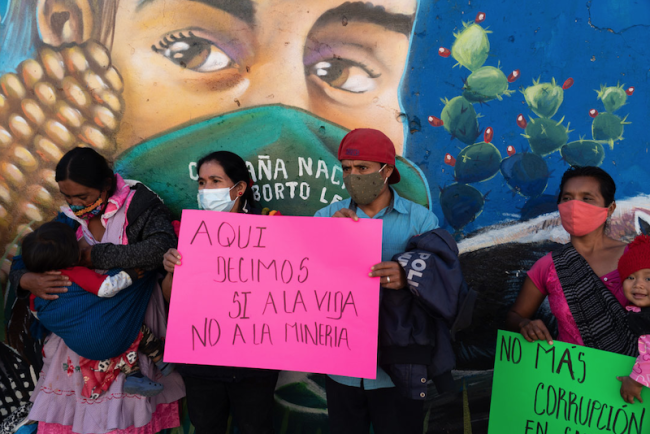
This is an excerpt of an article originally published in Spanish and English by Avispa Midia.
Leer el artículo completo en español.
Keving Hernán Sánchez, an Indigenous Zoque man from Oaxaca, Mexico, left his community at a young age to move to the state’s capital and study literature. He never imagined that after graduating and returning to his territory he would have to learn how to defend it. But that is what happened when a mining project threatened to tear apart the social and environmental fabric of his town.
Hernán hails from Los Chimalapas, a region in southern Mexico spanning 1,468,000 acres (594,000 hectares). According to the National Commission for Knowledge and Use of Biodiversity (CONABIO), the region contains areas of “extreme priority for conservation” because they function as a biological corridor that, along with other ecosystems, make Oaxaca the most biodiverse state in the country.
Data from the National Institute of Ecology and Climate Change (INECC) indicates that today Los Chimalapas “is one of the most important tropical areas and resource banks in Mexico and Mesoamerica. One sole hectare of undisturbed tropical vegetation in this region is estimated to contain up to 900 plant species.” It’s also home to endangered species such as cycads in the Ceratozamia genus and palms in the Chamaedora genus.
More than 200 animal species also live there, including several that are vulnerable or threatened: the mealy parrot, great curassow, keel-billed motmot, black solitary eagle, wood stork, and others.
However, despite its natural riches, 422 mining concessions have been authorized throughout the state of Oaxaca as of December 2022, putting its residents, flora, and fauna at risk. There is great concern over the significant amount of water used by mining operations, as well as groundwater contamination. On top of that, as the sources consulted for this report show, the Indigenous peoples who live in areas marked for mining don’t know what kinds of metals the companies want to extract from their territories and have not been consulted about the matter.
A study published in December 2020 by the University of Paraná’s Electronic Journal System states that Sonora, the state with the highest number of mines in the extraction phase in Mexico, suffers from significant water pollution from toxic substances. These include sulphuric acid, cyanide, and others. “Several mines have reported more than one spill and all of them are frequent, which causes concern as to how many have occurred over the course of the mine’s entire life cycle,” states the report.
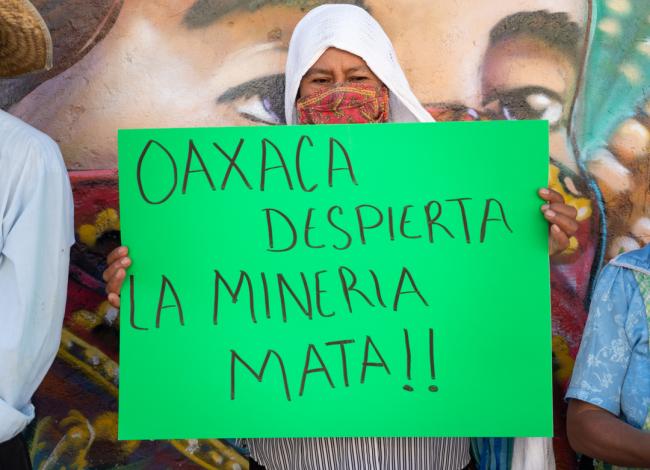
Los Chimalapas
The mining company that put Hernán on alert and set off alarm in Los Chimalapas, where he lives, is a Canadian-owned business called Minaurum Gold, Inc. Through its subsidiary Minera Zalamera SA de CV, it holds the title to mining concession #225472, the sole extraction rights for minerals underneath a land parcel titled “Jackita.” In 2020, the company began the approval process for an Environmental Impact Statement (EIS) for mineral exploration, which would allow them to take core samples.
Hernán and other young people found out about the mining project by chance in 2020—the government had not informed them—and after the surprise wore off, they created an independent research collective called Matza. In the Zoque language, “matza” means the first morning star. “That’s how we found out which company it was, the scale of the project, and that they were going to exploit gold and silver,” said Hernán.
Matza took charge of informing communities in the region about the proposed mine. The pueblos organized several demonstrations in 2020, showing the government that they did not want mining on their land. “Several tributaries come out of Los Chimalapas, which we live off of as do the majority of communities in the lowlands. All of this would be devastated and polluted,” said Hernán.
Asked about the mining concession’s status, Hernán responded: “The Ministry of Economy reported that there are no concessions in Los Chimalapas and there is nothing to worry about.”
Indeed, Eduardo Enrique Flores Magón y López, the Ministry of Economy’s General Director of Mines, declared in September 2020 that no mining concessions exist in the region: they are “only pending,” and with the current administration’s promise not to authorize new concessions, “obviously the concession will not be granted,” he said in a conference on economic reactivation programs held in the National Palace.
“So, we have to talk with our Zoque friends and tell them not to worry, that there is no concession. None of the companies have any right to extract, explore, or do anything related to mining in those communities,” he added.
However, cartographic databases of mining concessions valid in 2022, requested from the Ministry of Economy for this report, showed that there are two valid mining concessions in the Chimalapas region. They border each other and together span 16,000 acres (6,500 ha).
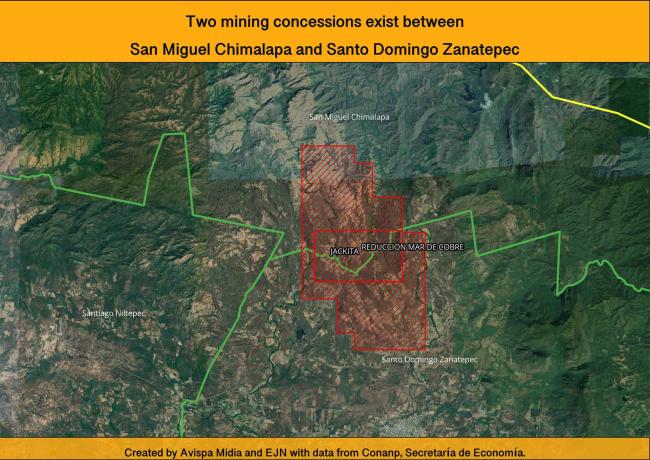
The two concessions belong to Minera Zalamera. One of them, under concession title #246936, corresponds to a land parcel named “Reducción del mar del cobre” and covers almost 12,000 acres (5,000 ha). It was issued in September 2020 while the people of Los Chimalapas demonstrated. Half of the concession is in San Miguel Chimalapa, the other half in the municipality of Santo Domingo Zanatepec.
The second concession, under title #225472, also spans the two towns. It corresponds to the Jackita parcel and measures 1,240 acres (500 ha).
The authors of this report requested an interview with Eduardo Enrique Flores Magón y López to corroborate this information but were told by his secretary Gloria Carmona that “he said he couldn’t take the call.” Although the public relations office, headed by Jesús Morales Martínez, agreed to interview, they did not respond by the time this report was published.
Indigenous Peoples Value Their Territories
The Matza collective knows the importance of their biodiverse territories, which help limit the increase in global temperature through their rich plant life. In contrast, “mining projects are an attack on life itself, and not only in Los Chimalapas but beyond, because this region connects with the rest of Oaxaca and all the way to Central America. In the context of the climate crisis, we can’t continue with or allow more depredation,” said Hernán.
He pointed out that “Canadian mining continues on; employees have been seen in other communities bringing false promises of healthcare and jobs, using deceitful rhetoric. Some people who don’t know about the impacts of mining believe them, and this causes fractures in the fabric of the community.”
Viviana Herrera, the Latin America Program Coordinator for MiningWatch, a non-governmental organization (NGO) based in Ottawa, Canada, said that “businesses incentivize the division of communities in order to gain the support of one faction, and then that’s how they present themselves to their investors, as if nothing happened.”
Herrera added that that is why the impacts are “social as well as environmental and begin the moment the rumor spreads that there’s a concession, all the way through the process of exploration and exploitation.”
Because MiningWatch has monitored the negative effects of Canadian mining companies in Latin America, Herrera explained, she can confirm that “the actions of mining companies repeat themselves in the region. The companies don’t inform people, they dodge all responsibility for environmental contamination, and often, they just abandon the mine once they’re finished with exploitation.”
Of the 422 mining concessions in Oaxaca registered with the Ministry of Economy, 297 have “valid” status in 2022. Concessions are valid for 50 years, with the possibility of another 50 years extension. This means that these 297 are being utilized in some manner, be it exploration or mineral exploitation.
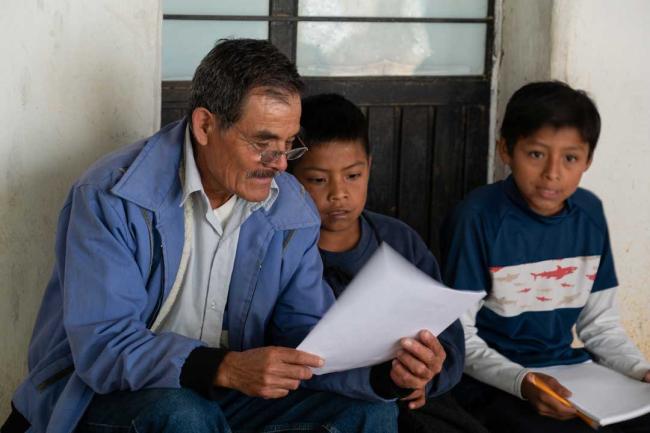
The Same Company, the Same Risk
Erika Carbajal Morales, like Hernán, is Indigenous, but from the Chontal people. She has had to confront the same Canadian company, in this case in the courts, since she is a lawyer. Some of the Chontal people live in the Sierra Sur mountains, which are also home to much of Oaxaca’s biodiversity, according to a report titled “Oaxaca, el estado con mayor diversidad biológica y cultural de México, y sus productos rurales” (“Oaxaca, the Most Biologically and Culturally Diverse State in Mexico, and its Rural Products”). “The greatest biological as well as cultural diversity and richness is concentrated in municipalities located in the state’s Sierra Norte and Sierra Sur,” states the document, published by the National Autonomous University of Mexico (UNAM).
Despite this, Minera Zalamera owns concession #238447, spanning more than 12,000 acres (5,000 ha) of Chontal territory, and intends to extract gold, silver, copper, zinc, and lead, directly putting seven Chontal communities at risk, Carbajal warned.
Carbajal works with Tequio Jurídico, a legal NGO dedicated to defending Indigenous rights and territory. She remembers the year 2014 clearly, because as she tells it, that was when she found out there was a mining concession in Chontal territory. Faced with this situation, the NGO and Chontal agrarian authorities started organizing regionally to find out what this project could mean. “It caused a great deal of concern, thinking that we were going to disappear as peoples due to the impacts on the social fabric of the communities and on [our] ecosystems,” said Carbajal.
Sixteen Chontal communities began to organize their resistance, creating the Chontal People’s Assembly for the Defense of Our Territory “as a form of regional defense,” the lawyer stated.
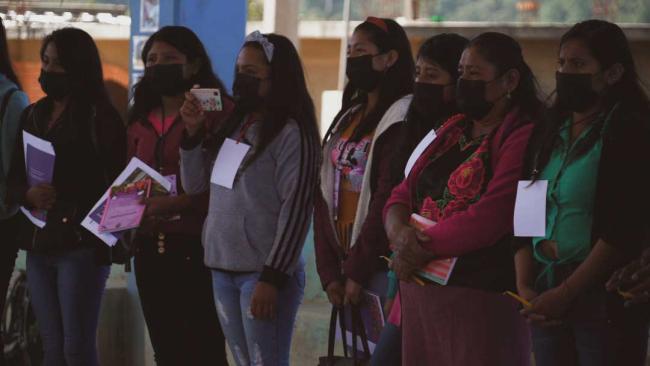
The Chontal communities, like other Indigenous peoples in Oaxaca, keep most of their lands as “common goods,” said Carbajal, meaning that private property barely exists there. Their highest authority is the community assembly, where they come to consensus on the main agreements they must hold themselves to. “Accordingly, their diverse forms of exercising autonomy and self-determination must be legally recognized in the country,” said Carbajal.
With that in mind, a legal strategy was created using juridical tools based on the rights to free determination and autonomy, which empowered youth from the communities to update the community statutes that their forms of government oversee. That is how, said Carbajal, “the prohibition of mining projects in the Chontal region was established, and this decision was recognized by the National Agrarian Register (RAN).”
Armando De La Cruz, another lawyer from Tequio Jurídico, affirmed that “once these agreements are registered by the RAN, they can be used as legal support for the defense of communities. And because it’s a decision made by exercising autonomy and free determination, it’s a resource that other communities can draw on.”
The Chontal people also updated their comunero censuses—the RAN’s official record of campesinos with rights to communal lands—including women, which had not happened before. These strategies helped them demand that the courts suspend Minera Zalamera’s mining concession in the Chontal region.
These legal resources were used to file a suit with the Fourth District Court of Oaxaca against 21 federal authorities, from the President of Mexico to the Mining Registrar, for passing the Law on Mining without consideration of Indigenous rights. They were also sued for issuing the mining concession in question “without having informed or consulted the communities,” said De La Cruz.
In February 2020, Oaxaca’s Fourth District Judge granted the protection order requested in the suit for the entire Chontal people, said Carbajal, but “the judge defended the constitutionality and legality of the Law on Mining, claiming that it did not violate human rights. But based on the facts this has been challenged legally by several peoples around the country.”
The mining concessions databases show that this company holds 15 currently valid concessions. It has neither consulted nor informed Indigenous communities about its planned activities for a single one of these concessions. Of the 15, there are 11 in the state of Oaxaca—on Indigenous land—two in Guerrero, one in Puebla, and one in Morelos. In total, they cover 116,020 acres (46,952 ha).
Minera Zalamera does not have a website or publicly available contact information, even in the Mexican government’s mining directory. At the time of this report’s publication, Minera Zalamera’s parent company Minaurum Gold had not responded to a request for comment.
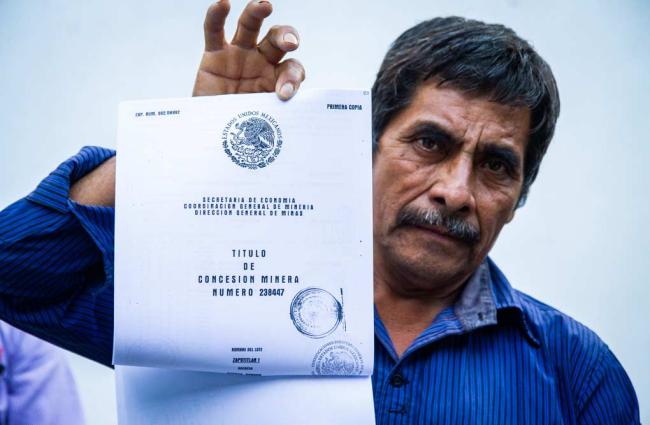
New Concessions
Andrés Manuel López Obrador, the current president of Mexico, said when he took office in 2018 that he would not grant new concessions. In response to the information request made to the Ministry of Economy, he reaffirmed this position.
However, the databases consulted for this report show that from 2019 to 2021, at least 163 new concessions totaling 988,204 acres (399,912 ha) have been granted in Mexico, all to companies that already owned other concessions. Thirteen of the new concessions are in Oaxaca. Nine of them were awarded to the company Don David Gold México SA de CV, a subsidiary of the US-based Gold Resource Corporation (GRC), one of the companies that already holds more than 124,000 (50,000 ha) in mining concessions in Oaxaca alone.
Don David Gold is one of two companies currently extracting gold and silver in Oaxaca. An investigative report conducted by Avispa Midia documented that the company has two active mines: El Águila and Alta Gracia, in operation since 2010 and 2017, respectively, which together extract almost 2,200 tons (2 million kg) of material per day.
The investigation reported that the company does not have a public record reporting the daily amount of water used. According to information from the National Water Commission (CONAGUA), it has a license to extract up to 39 million gallons (150,000 cubic meters) of water per year from the Grande-Tehuantepec River, through concession 05OAX137811/22FSDA16.
A report by the Heinrich Böll Foundation titled “Concesiones de agua para las mineras” (Water Concessions for the Mining Companies) highlights the fact that the Ministry of Economy does not publicly report on the minerals that companies extract, much less the water consumed in the processes of exploration, exploitation, and mineral beneficiation.
Asked if she knew about the new concessions, Carbajal replied, “The new administration said they wouldn’t grant new concessions. As Indigenous peoples, now we have to prepare ourselves even more to defend our territory.”
Meanwhile, Hernán appeared uncertain, because his community still lacks information about the two concessions in Los Chimalapas. “We have to look for more information and continue to organize, because we’re going to defend Los Chimalapas. We have to work on territorial defense with our brother and sister pueblos—if we don’t, we’ll die out,” he concluded.
Santiago Navarro F is an economist, journalist, photographer, and documentary filmmaker. He is co-founder of the investigative journalism portal Avispa Mídia, a contributor to the Truthout, and a prominent member of the Connectas Journalistic Community.
This story was produced with support from Internews’ Earth Journalism Network.

